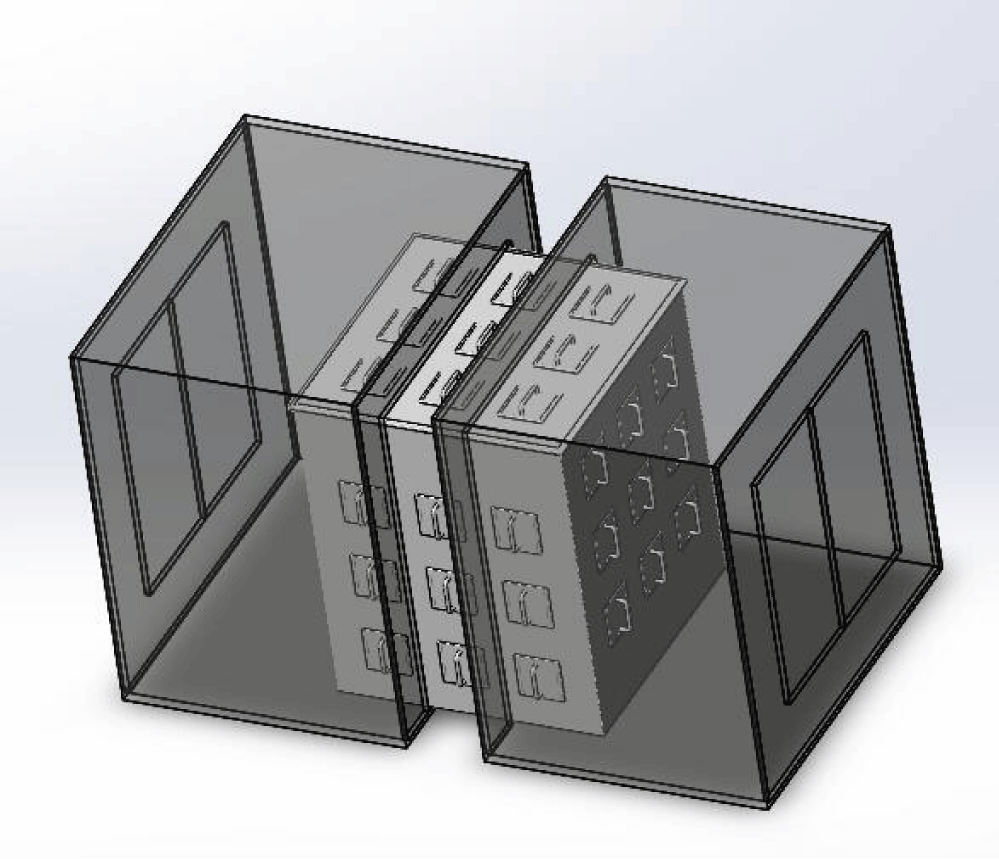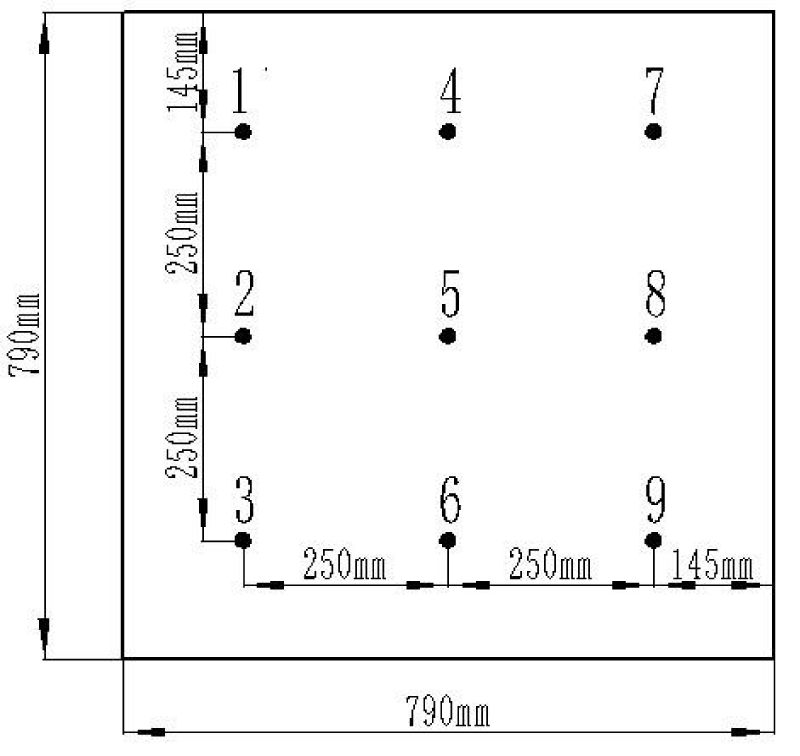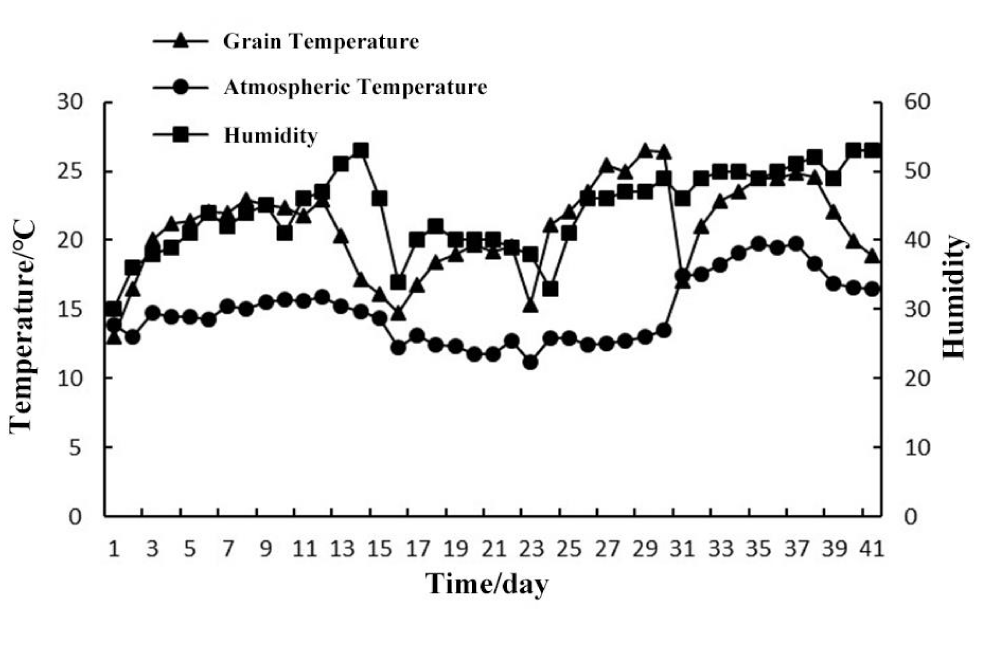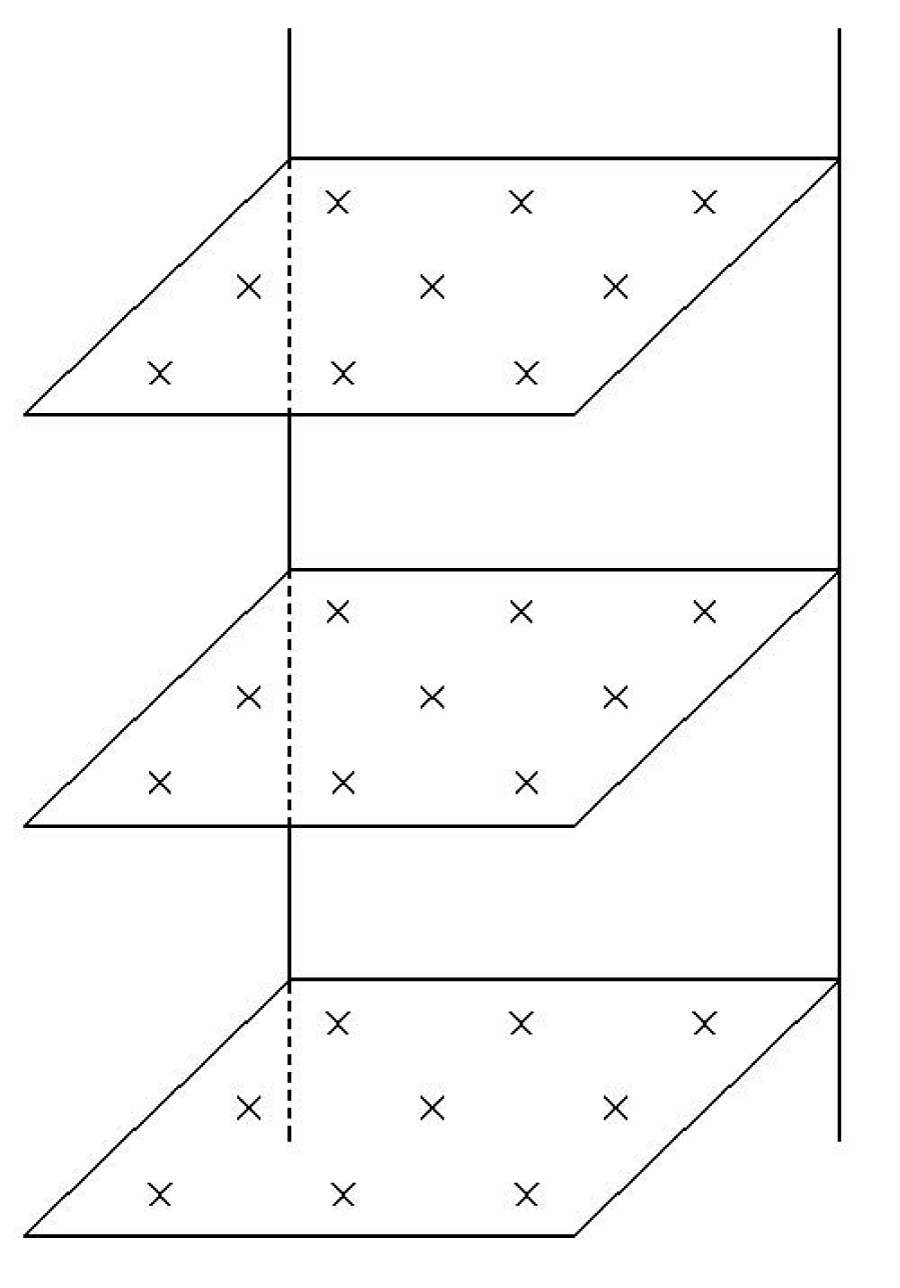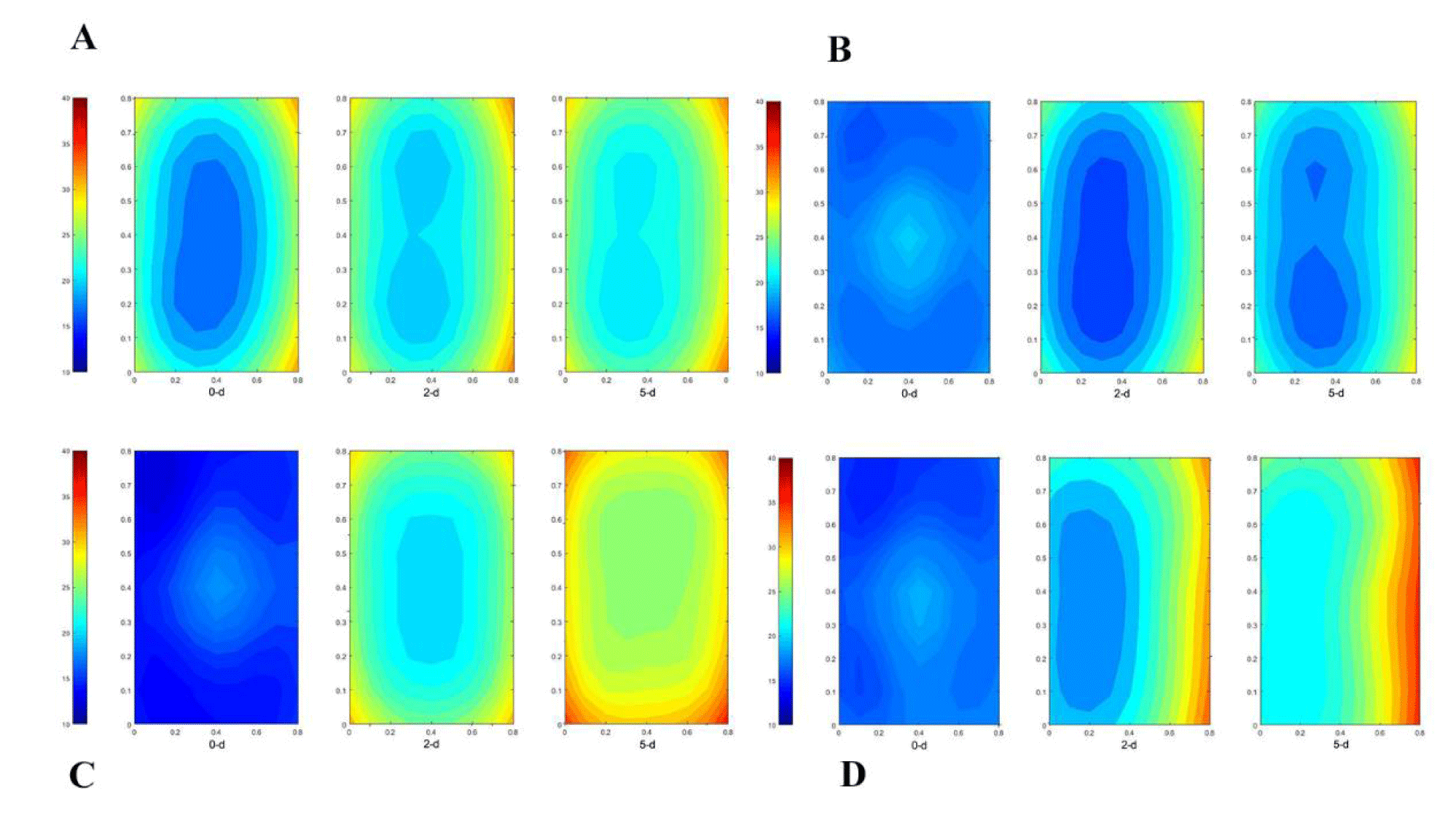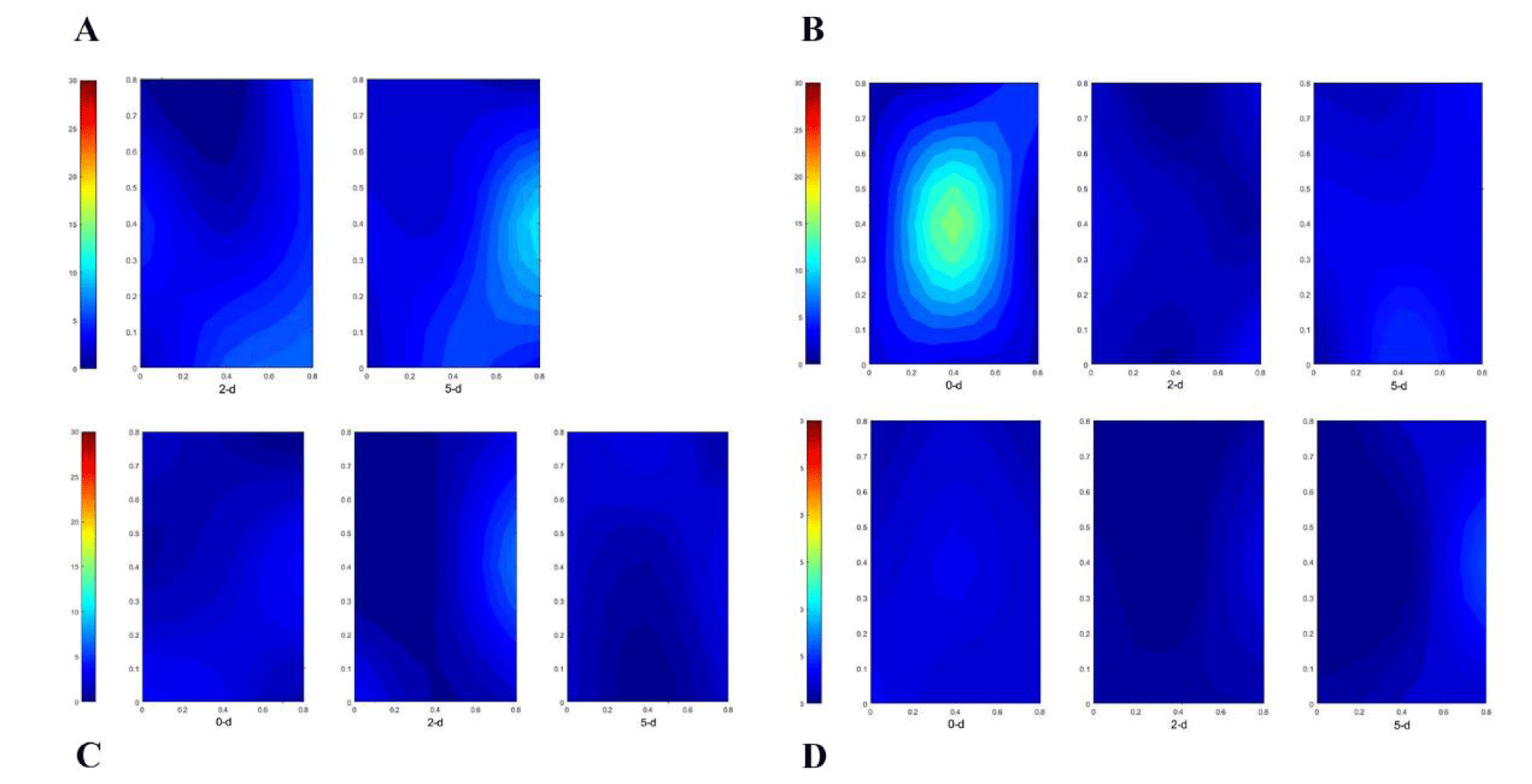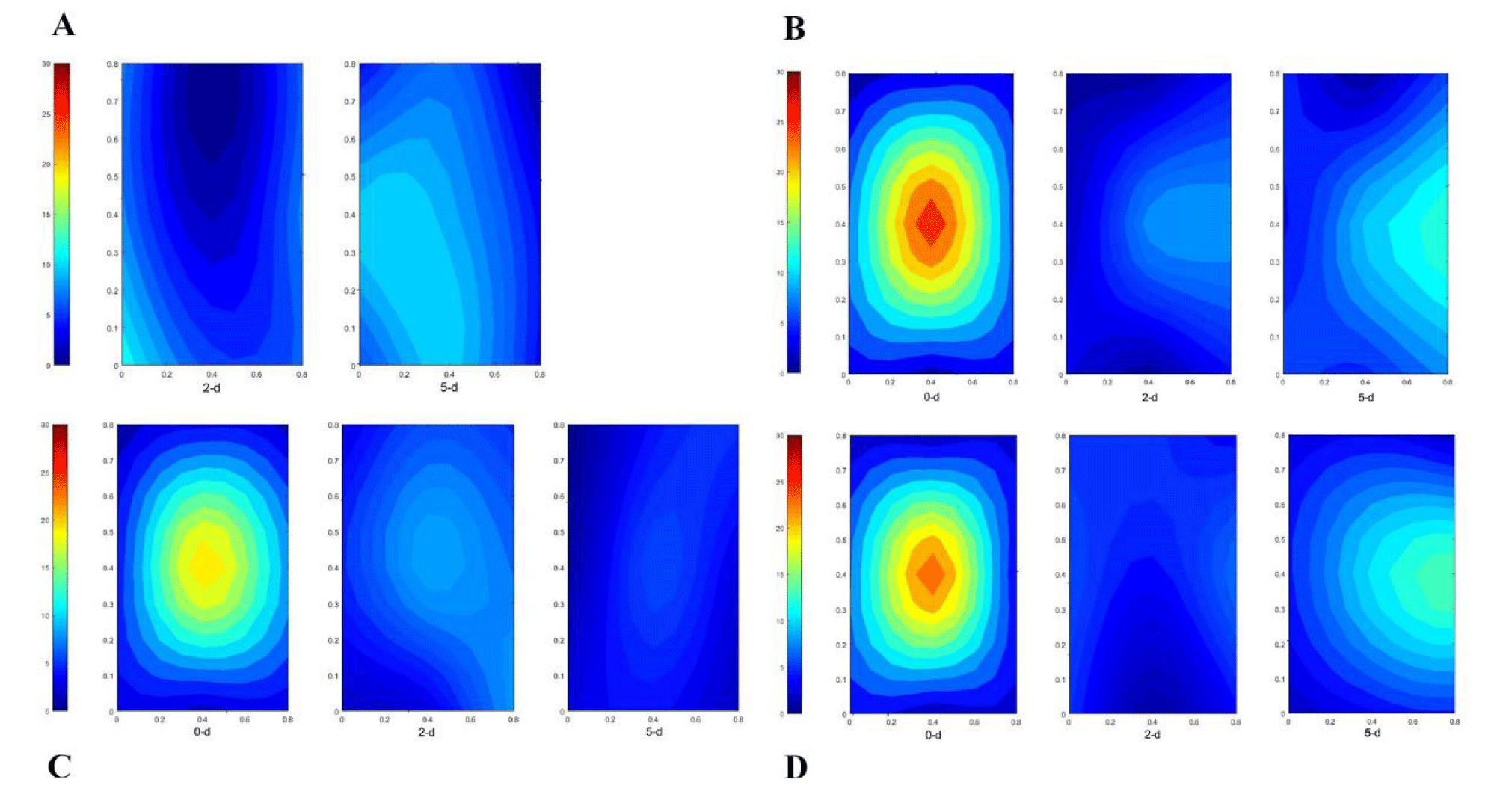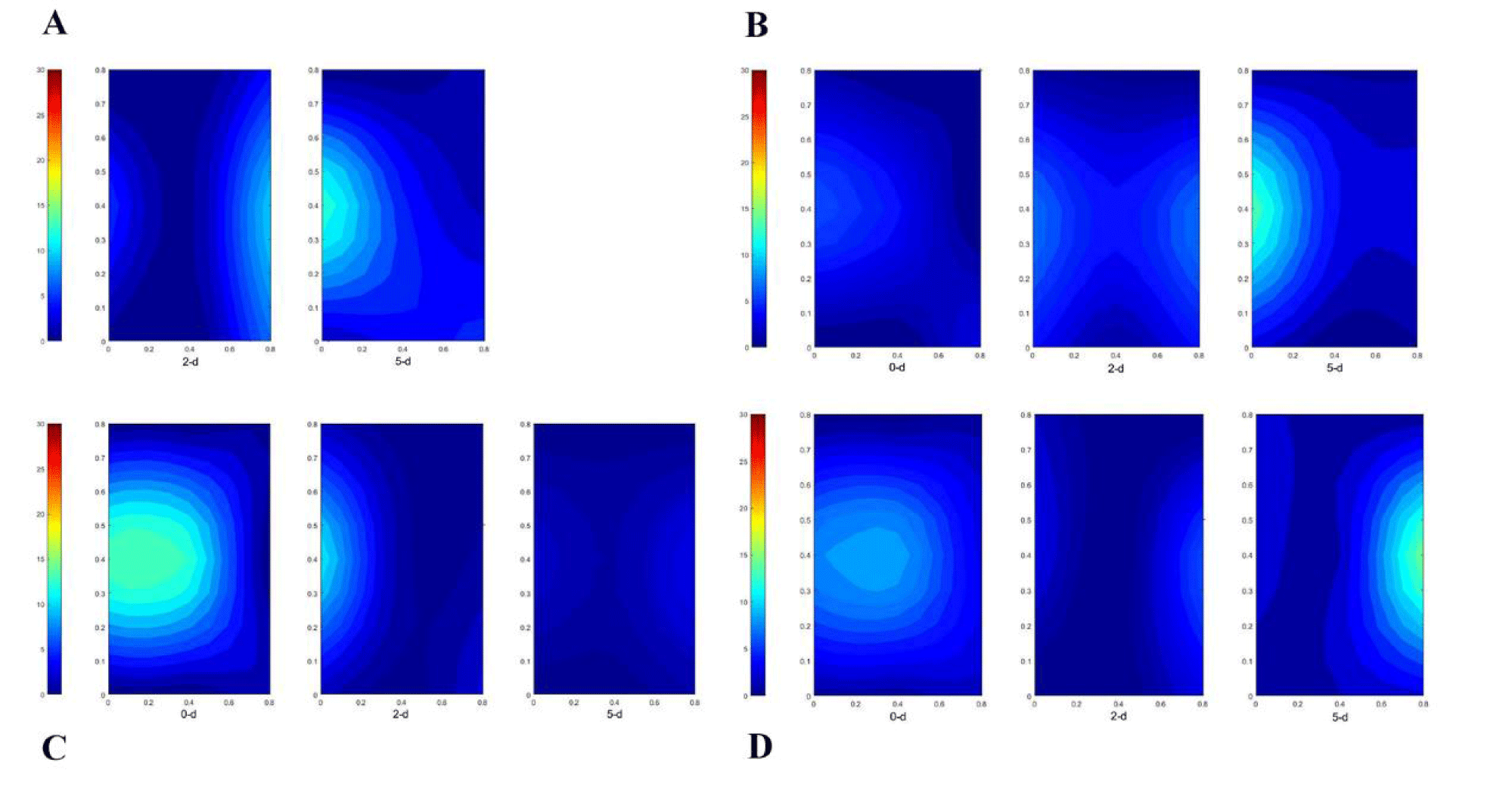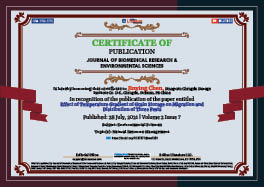> Environmental Sciences. 2021 July 28;2(7):632-640. doi: 10.37871/jbres1289.
Effect of Temperature Gradient of Grain Storage on Migration and Distribution of Three Pests
Zhenya Mu1, Jin Wang1, Yan Zhang2, Xiaozhe Qi2, Li Li1 and Jinying Chen1*
2Standards and Quality Center of National Food and Strategic Reserves Administration, Xicheng District, Beijing, China
- Temperature gradient
- Grain storage
- Stored grain pests
- Migration and distribution
Abstract
Temperature gradients were set at the opposite sides of the grain storage: 25°C-30°C, 20°C-30°C, 20°C-35°C, 30°C-30°C. The migration and distribution of imago of Sitophilus oryzae, Rhizopertha dominica and Tribolium castaneum in the grain storage were observed. The results showed significant differences that the distribution trends of imago of Sitophilus oryzae, Rhizopertha dominica and Tribolium castaneum within a certain grain storage temperature gradient (p < 0.05). The temperature gradient of grain storage is 25°C-30°C. Tribolium castaneum tends to gather in the 30°C side area of grain storage, while Sitophilus oryzae has no obvious trend, while Rhizopertha dominica tends to gather in the 25°C. The temperature gradient of grain storage is 20°C-30°C. Both Tribolium castaneum and Sitophilus oryzae tend to gather in the 30°C side area of grain storage, while Rhizopertha dominica tends to gather in the 20°C. The temperature gradient of grain storage is 20°C-35°C. Tribolium castaneum, Sitophilus oryzae and Rhizopertha dominica all tend to gather in the area on the side of grain storage at 35°C. The temperature gradient of grain storage is 30°C-30°C, and there is no obvious trend for Tribolium castaneum. Rhizopertha dominica tends to gather in the 30°C area on the left side of grain storage, while Sitophilus oryzae tends to gather in the 30°C area on the right side of grain storage. After cooling down, it was found that Sitophilus oryzae tended to gather in the center of the grain storage, while the Tribolium castaneum had no obvious trend, and the Rhizopertha dominica tended to gather in the peripheral area of the grain storage.
Background
Tribolium castaneum (Herbst) belongs to Coleoptera (Tenebrionidae) and is a worldwide distribution of stored grain pests [1,2]. It has a distribution of at least 23 provinces (regions) in China [3]. It is omnivorous, widely adapfigure, and has fast reproduction. Moreover, adult Tribolium Castaneae has stinky glands in its body, which can secrete stinky liquid to cause flour pollution and caking. It has peculiar smell and cannot be eaten, resulting in serious deterioration of grain quality and loss of quality. Sitophilus oryzea (Linnaeus) belongs to Coleoptera Curculionidae, which often occurs in temperate and tropical regions. It can produce 4-12 generations a year. In wheat with 12.5% and 13.5% moisture content, the starting temperature of rice development is 15.82°C and 14.45°C respectively, and the optimum development temperature is 27.5°C [4]. Each female lays up to 576 eggs in a suifigure environment. Larvae often eat in the host. Rhizopertha dominica (Fabricius) belongs to Coleoptera bostrichidae, which is mainly distributed in tropical and subtropical regions. In China, it is mainly suffered severely in South China. Rhizopertha dominica has strong environmental adaptability, strong resistance to dryness, heat and drug [5,6]. Damaged grains are often eaten into empty shells, which is extremely harmful to grain. Tribolium castaneum, Sitophilus oryzae and Rhizopertha dominica are important pests that are easy to occur in the storage process of raw grains such as rice, wheat and corn, and often occur with each other. Sitophilus oryzae and Rhizopertha dominica are important early-stage moth-eating pests, while Tribolium castaneum is an important late-stage powder-eating pest. The former moth-eating raw grains results in an increase in the amount of crumb in grain storage, creating favorable conditions for the latter’s living environment.
Migration and distribution of stored grain pests in grain storage are closely related to external environmental factors such as temperature, illumination, gravity, grain moisture content, gas concentration and pheromone [7-12]. Temperature is one of the most important factors affecting migration and distribution of stored grain pests [13,14]. As stored grain pests are Poikilotherm, they will react differently in different temperature ranges. When the external temperature exceeds their suifigure temperature range, the growth, development and migration behavior of stored grain pests will be affected [15,16]. Changes in grain storage temperature restrict the occurrence, development and distribution of stored grain pests in grain storage. The species, sex, development stage, density and other factors of stored grain pests may also be related to their migration and distribution in grain storage [17-20].
At present, scholars at home and abroad have reported some relevant research data. Domestic scholars [21] have studied the movement behavior of Sitophilus oryzae under different conditions by using wheat grain columns with temperature difference. It is found that Sitophilus oryzae are mostly distributed in the range of 22°C-31°C, and the movement rate of Sitophilus oryzae above 10°C increases with the increase of grain temperature [22] found that the creep onset temperature of Tribolium castaneum was 17°C, and the diffusion rate in horizontal grain column was about 1.2~3.1 times that in vertical grain column. Foreign scholar [23] reported that Cryptolestes ferrugineus (Stephens) preferred to be distributed in the areas with higher temperature in the grain storage, and would migrate from the surface of the grain storage with lower temperature to the central area of the grain storage with higher temperature after cooling in autumn and winter. Studied the mortality and distribution of Tribolium castaneum and Rhizopertha dominica during grain storage cooling [24]. Studied the three-dimensional dynamic distribution of Tribolium castaneum and Sitophilus oryzae in time and space under different temperatures, different water contents and different pest densities in grain storage [25]. The results showed that both species of insects would gather in groups under different conditions, but adults of Tribolium castaneum were easier to uniform distribution than adults of Sitophilus oryzae. In addition, the migration and distribution laws of Cryptolestes ferrugineus (Stephens), Tribolium castaneum and Sitophilus oryzae were also studied in detail [26-29].
Most researches on the influence of temperature on the life activities of stored grain pests are often carried out at a constant temperature in the laboratory. Stored grain pests are forced to live in an artificially set experimental environment. However, in actual situations, the environment temperature in the grain storage is not constant. Stored grain pests can actively choose their preferred environment temperature in the grain storage and migrate to a living environment suifigure for their growth and development. Therefore, this thesis uses an appropriate temperature gradient generating device. The research on the influence of temperature gradient on the migration and distribution of three stored grain pests, namely, Tribolium castaneum, Sitophilus oryzae and Rhizopertha dominica, in grain storage is carried out, which provides certain reference basis for clarifying the occurrence and development law of stored grain pests, reasonably determining the sampling points of stored grain pests, improving the accuracy of predicting the occurrence and development harm degree of pests in granaries, and developing new pest control methods.
Materials and Methods
Test samples and insect sources
The tested insect species are Rhizopertha dominica, Sitophilus oryzae and Tribolium castaneum. They are taken from zooecium of Chengdu Storage Research Institute of China Grain Reserves. There are 550 insects of each species, totaling 1,650. After the test, all of them are put into the center of the grain storage. The tested rice is late indica rice, totaling 330kg, with a moisture content of 13.0% ± 1%.
Test equipment
Steel plate cabinet: 790 mm×790 mm×935mm Indoor heater: manufacturer Haier Group, product model HNS1803, rated power 1800W; Heat preservation cabinet: 110 mm× 82 mm× 110 mm. Heaters are used to set different temperatures at the left and right sides of the steel plate cabinet filled with rice: 25°C-30°C, 20°C-30°C, 20°C-35°C, 30°C-30°C, making the grain storage in the steel plate cabinet present continuous temperature gradient. Installation of steel plate cabinet and thermal insulation cabinet is shown in figure 1.
Temperature acquisition plan
The computer is connected to the temperature measuring unit to collect the temperature data inside the grain storage every 30 min. The temperature measuring unit is connected to the temperature measuring cable. There are 9 temperature measuring cables, which are arranged in a 3×3 array and are evenly inserted into the grain storage. The schematic diagram of horizontal section is shown in figure 2. Each cable is provided with 4 temperature sensors, 150 mm, 350 mm, 550 mm and 750 mm from the grain flour respectively, totaling 36 temperature measuring points. Figure 3 shows the change chart of air temperature, air humidity and grain temperature during the test. The air temperature, air humidity and grain temperature are all average values. The indoor air temperature is kept at about 15°C, and the change range is obviously lower than that of air humidity and grain temperature.
Pest sampling plan
The pest sampling point corresponds to the schematic position of the horizontal section of the temperature measuring cable in figure 2. The JQYS type granary deep sampler is used to sample grains of different depths in the vertical column where each cable is located three times, with different depths of 0-300 mm, 300mm~600mm and 600mm~900mm respectively. As shown in figure 4, “×” means pest sampling point, with a total of 3 layers of 27 sampling points, sampling 1kg of grain each time. The grain sample is repeatedly sieved by using a pest selection sieve, each time the sieving time is not less than 1min. After sieving, the pests are separated from the grain particles by hand picking, and the pests picked out by the sieve layer and the pests in the undersize are counted together and then put back to the corresponding sampling position after statistics. The pest selection sieve used was bought from Zhejiang Bethlehem Apparatus Co., Ltd, model JJSC30, which comprises an intermediate sieve layer and a bottom cover, wherein the outer diameter of the intermediate sieve layer is 300mm and the diameter of the sieve hole is 2.5 mm. The temperature gradient of each group was screened 4 times, the screening time was 0d, 2d, 5d and after the temperature of the grain storage was reduced to 15°C.
Data processing
The data were processed by Microsoft Excel, and the nephogram was drawn by MATLAB software and SPSS was used for one-way ANOVA.
Results
As shown in figure 5, the nephogram corresponding to “0-d”, “2-d” and “5-d” under different temperature gradients show the grain temperature distribution results after setting the temperature gradient for 0 days, 2 days and 5 days respectively. When the left and right sides of the steel plate cabinet start heating, the overall temperature of the grain storage gradually rises, and the rising speed of the peripheral temperature of the grain storage is higher than the rising speed of the central temperature of the grain storage. After the heating is stopped, the overall temperature of the grain storage gradually falls, and the falling speed of the peripheral temperature of the grain storage is higher than the falling speed of the central temperature of the grain storage. While the grain temperature changes, the distribution of the three stored grain pests (Tribolium castaneum, Sitophilus oryzae and Rhizopertha dominica) in the grain storage also changes. Figures 6-8 shows the distribution results of three stored grain pests in the grain storage under different temperature gradients, and nephograms corresponding to “0-d”, “2-d” and “5-d” respectively show the distribution results of stored grain pests after the grain storage has been set with a temperature gradient of 0 days, 2 days and 5 days. Table 1,2 shows the percentage of three stored grain pests distributed in grain storage under different temperature gradients, of which “left” corresponds to sampling columns 1, 2 and 3 and is distributed on the side with lower temperature gradient. “Middle” corresponds to sampling columns 4, 5 and 6; The “right side” corresponds to the sampling columns 7, 8 and 9 and is distributed on the side with higher temperature gradient. When the temperature gradient of the grain storage is between 25°C and 30°C, the three stored grain pests are all distributed in the center of the grain storage at 0-d.
| Table 1: The distribution results of three stored grain pests in grain bulk with temperature. | ||||
| Temperature/°C | Location | T. castaneum /% | S. oryzea /% | R. dominica /% |
| 25-30 | Left side | 21.68 ± 1.60c | 41.67 ± 6.07a | 44.91 ± 6.23a |
| Middle side | 28.62 ± 4.57b | 34.47 ± 18.08a | 20.01 ± 7.92b | |
| Right side | 49.69 ± 2.99a | 23.86 ± 12.20a | 32.40 ± 15.67b | |
| Left side | 24.84 ± 10.51b | 21.82 ± 3.65c | 54.16 ± 10.76a | |
| 20-30 | Middle side | 31.37 ± 11.93ab | 29.70 ± 1.83b | 18.84 ± 1.69b |
| Right side | 43.78 ± 2.88a | 48.48 ± 1.76a | 27.04 ± 11.01b | |
| Left side | 14.67 ± 9.38b | 25.20 ± 9.88b | 27.36 ± 7.26b | |
| 20-35 | Middle side | 21.00 ± 7.50b | 32.80 ± 7.35ab | 10.23 ± 8.89c |
| Right side | 64.34 ± 2.13a | 42.00 ± 2.99a | 62.40 ± 1.63a | |
| Left side | 36.08 ± 10.44a | 19.65 ± 4.87b | 47.78 ± 24.23a | |
| 30-30 | Middle side | 21.00 ± 5.29a | 43.33 ± 6.29a | 11.65 ± 5.80b |
| Right side | 42.92 ± 15.12a | 37.02 ± 4.15a | 40.57 ± 18.89ab | |
| Data in the table are Mean ± SD. Means follows by different letters in the same column are significantly different at 0.05 level. | ||||
| Table 2: The distribution results of three stored grain pests in grain bulk after cooling. | |||
| Location | T. castaneum /% | S. oryzea /% | R. dominica /% |
| Left side | 29.63 ± 11.56a | 22.15 ± 4.21b | 43.11 ± 6.16a |
| Middle side | 43.52 ± 13.13a | 54.32 ± 0.37a | 36.67 ± 8.82a |
| Right side | 26.85 ± 1.61a | 23.53 ± 4.57b | 20.22 ± 8.95b |
| Data in the table are Mean ± SD. Means follows by different letters in the same column are significantly different at 0.05 level. | |||
Distribution of Tribolium castaneum in grain storage under different temperature gradient
The distribution results of Tribolium castaneum in grain storage under different temperature gradients are shown in figure 6. Combined with figure 1, it is found that when the left and right sides of the steel plate cabinet are set at 25°C-30°C, the number of Tribolium castaneum on the right side of grain storage is significantly higher than the number of Tribolium castaneum in the middle and left sides of grain storage, and Tribolium castaneum tends to be distributed in the 30°C side area of grain storage. The pest density reached 6/kg, and the pest density on the left side of the grain storage was 3/kg. When the left and right sides of the steel plate cabinet are set at 20°C-30°C, the number of Tribolium castaneum on the right side of the grain storage is significantly higher than that on the left side of the grain storage. Tribolium castaneum tends to be distributed in the area on the 30°C side of the grain storage, with pest density reaching 4/kg. The density of pests on the left side of grain storage is 2/kg. When the left and right sides of the steel plate cabinet are set at 20°C-35°C, the number of Tribolium castaneum on the right side of the grain storage is significantly higher than that on the left and middle of the grain storage. Tribolium castaneum tends to migrate and distribute to the area on the 35°C side of the grain storage with a pest density of 4/kg and 1/kg on the left side of the grain storage. When the left and right sides of the steel plate cabinet are both set at 30°C, the Sitophilus oryzae is randomly distributed in the grain storage, with no significant difference, and the pest density reaches 2/kg. The results showed that Tribolium castaneum showed a remarkable thermotaxis, and tended to gather in areas with higher grain temperature in grain storage with a certain temperature difference.
Distribution of Sitophilus oryzae in grain storage under different temperature gradient
The distribution results of Sitophilus oryzae in grain storage under different temperature gradients are shown in figure 7. Combined with figure 1, it is found that when the left and right sides of the steel plate cabinet are set at 25°C-30°C, Sitophilus oryzae are randomly distributed in grain storage with no significant difference. The pest density in grain storage reaches 7/kg. The reason why there is no obvious trend may be that the temperature difference between the two sides is too small. Sitophilus oryzae did not show obvious preference trend. When the left and right sides of the steel plate cabinet are set at 20°C~30°C, the number of Sitophilus oryzae on the right side of the grain storage is significantly larger than that on the left and middle of the grain storage. The Sitophilus oryzae tend to gather and distribute in the area on the 30°C side of the grain storage, with the pest density reaching 9/kg and 5/kg on the left side of the grain storage. When the left and right sides of the steel plate cabinet are set at 20°C-35°C, the number of Sitophilus oryzae on the right side of the grain storage is significantly larger than that on the left side of the grain storage. The Sitophilus oryzae tend to gather and distribute in the area on the 35°C side of the grain storage, with the pest density reaching 7/kg and /kg on the left side of the grain storage. When the left and right sides of the steel plate cabinet are both set at 30°C, the number of Sitophilus oryzae on the right and middle of the grain storage is significantly larger than that on the left side of the grain storage. The Sitophilus oryzae tend to migrate to the 30°C area on the right side of the Grain storage, with pest density reaching 5/kg and 2/kg on the left side of the grain storage. The results show that there is no obvious trend in the grain storage temperature gradient of 25-30°C. In the grain storage temperature gradient of 30-30°C, the Sitophilus oryzae image shows certain randomness and aggregation. In the grain storage with certain temperature difference, the Sitophilus oryzae image finally tends to aggregate in the area with higher grain temperature.
Distribution of Rhizopertha dominica in grain storage under different temperature gradient
The distribution results of Rhizopertha dominica in grain storage under different temperature gradients are shown in figure 8. Combined with figure 1, it is found that when the left and right sides of the steel plate cabinet are set at 25-30°C, the number of Rhizopertha dominica on the left side of grain storage is significantly larger than that in the middle of grain storage. Rhizopertha dominica tends to gather in the area on the 25°C side of grain storage, with the pest density reaching 5/kg and the pest density on the right side of grain storage being 3/kg. When the left and right sides of the steel plate cabinet are set at 20°C-30°C, the number of bark Rhizopertha dominica on the left side of the grain storage is significantly larger than that on the right side and the middle of the grain storage. The bark Rhizopertha dominica tend to gather in the area on the 20°C side of the grain storage, with a pest density of 6/kg and 2/kg on the right side of the grain storage. When the left and right sides of the steel plate cabinet are set at 20°C-35°C, the number of Rhizopertha dominica on the right side of the grain storage is significantly larger than that on the left and middle of the grain storage. The Rhizopertha dominica tend to gather and distribute in the area on the 35°C side of the grain storage, with the pest density reaching 7/kg and the pest density on the left side of the grain storage being 3/kg. This phenomenon may be due to the increased mobility of the Rhizopertha dominica when the grain storage temperature is greater than 30°C, which prefers the high temperature area. When the left and right sides of the steel plate cabinet are both set at 30°C, the number of Rhizopertha dominica on the left side of the grain storage is significantly higher than that in the middle of the grain storage, and there is no significant difference with the number of Rhizopertha dominica on the right side of the grain storage. The pest densities on the left and right sides of the grain storage are 2/kg and 1/kg respectively. The results showed that when the temperature range was 20°C-30°C, the bark Rhizopertha dominica tended to gather in areas with lower grain temperature, while when the grain temperature gradient was 30°C-30°C, the bark Rhizopertha dominica showed certain randomness and aggregation, while when the grain temperature was higher than 30°C, they tended to gather in areas with higher grain temperature.
Distribution of three stored grain pests in grain storage after cooling
When the heating and cooling of the left and right sides of the steel plate cabinet are stopped, the overall temperature of the grain storage drops, the central temperature of the grain storage is higher than the peripheral temperature of the grain storage, and the central temperature of the grain storage drops to 18°C. From the distribution maps of the three stored grain pests and figure 2, it can be seen that the distribution area of the Sitophilus oryzae changes most obviously after cooling. The number of the Sitophilus oryzae gathered in the middle of the grain storage is significantly higher than the number of the Sitophilus oryzae on the left and right sides of the grain storage, and tends to be distributed in the center of the grain storage, with Rhizopertha dominica tends to gather and distribute in the left area of the grain storage, with the pest density reaching 3/kg. This phenomenon is related to Ahmed Y. The results of [24] study are similar. Rhizopertha dominica is susceptible to low temperature, and few of them migrate to the central area of grain storage after cooling. After cooling down, there was no obvious trend of Tribolium castaneum in grain storage, and the density of pests in grain storage reached 4/kg. The obvious regional difference between the distribution of Tribolium castaneum and Sitophilus oryzae after the grain storage is cooled down may be due to the different initial crawling temperatures of Tribolium castaneum and Sitophilus oryzae. After the grain storage is cooled down, the peripheral temperature is in the range of 10°C~15°C. Sitophilus oryzae only crawls when the environment temperature is higher than 10°C, while the initial crawling temperature of Tribolium castaneum is 15°C [30,31].
Discussion
Changes in temperature have an important impact on the life activities of stored grain pests. Research on the migration and distribution of stored grain pests under the temperature gradient of grain storage is helpful for us to study and understand the relationship between stored grain pests and changes in grain temperature. Key screening should be carried out for areas where stored grain pests may breed in grain storage, so as to accurately control the occurrence, development and distribution of stored grain pests in grain storage, take timely preventive measures, and avoid the occurrence of large-scale and large-scale stored grain pests. The migration and distribution of stored grain pests in grain storage have certain randomness and aggregation. When screening stored grain pests, grain depots should reasonably determine screening points according to the distribution characteristics of different insect species and different grain temperature regions, scientifically and accurately estimate the occurrence, development and damage degree of stored grain pests, and pay attention to check and prevent the spread of infestation of Rhizopertha dominica at 20-25°C in grain warehouses. The positions of grain storage above 30°C should be listed as the screening focus. The peripheral temperature of the granary drops faster than the central temperature in autumn and winter. Attention should be paid to check and prevent the migration of Sitophilus oryzae from the granary to the grain storage center. Rhizopertha dominica had different tendency under the temperature gradient of 20°C-30°C and 20°C-35°C, we need to design another experiment to study the main factor that affect its temperature preferences. Although Rhizopertha dominica migrates and distributes in areas with lower grain temperature in grain storage at temperatures higher than 20°C and lower than 30°C, the process of grain boring by Rhizopertha dominica leaves a large amount of powdery debris, which reduces the porosity of grain storage, weakens the ventilation and circulation fumigation effects of grain warehouses, resulting in abnormal increase of local grain temperature, reaching the optimum development temperature for the development of Rhizopertha dominica and causing a large number of propagation of Rhizopertha dominica. If sampling inspection and local prevention measures are not carried out at abnormal high temperature points of grain storage in time, Rhizopertha dominica will gradually expand the damage range and cause significant loss of stored grain. After all, the environment simulated by the laboratory is quite different from the natural environment of the real granary, such as the size of grain storage and the comprehensive influence of different environmental factors. Therefore, in order to more accurately grasp the migration and distribution laws of stored grain pests in granaries, it is necessary to conduct long-term observation and summary on the migration and distribution behaviors of stored grain pests occurring in real granaries.
Conclusion
The distribution trends of Sitophilus oryzae, Rhizopertha dominica and Tribolium castaneum in a certain grain storage temperature gradient showed significant differences (p < 0.05). There is no significant difference in the distribution of Sitophilus oryzae except at the grain storage temperature gradient of 25°C-30°C, which is consistent with the quantitative distribution of Tribolium castaneum in the grain storage with a certain temperature difference. They all tend to gather in the areas with higher grain temperature. The Rhizopertha dominica tends to gather in the areas with lower grain temperature in the grain storage temperature range of 20°C-30°C, and when the grain storage temperature is higher than 30°C, it tends to gather in the areas with higher grain temperature. When the temperature on both sides of the grain storage is 30°C, the Sitophilus oryzae, the bark Rhizopertha dominica and the Sitophilus oryzae all show certain randomness and aggregation. After the temperature was lowered, the Rhizopertha dominica stayed in the peripheral area of the grain storage under the influence of low temperature, and there was no obvious trend for Tribolium castaneum, and the Sitophilus oryzae tended to migrate to the center of the grain storage with higher temperature.
Acknowledgment
We thank Guo Daolin, Wang Shuanglin for their guidance and help in the experiment and paper writing. We thank Sinograin Chengdu Grain Storage Research Institute for the perfect experimental platform and 2015 grain public welfare industry for partial funding of this research. We thank Young Elite Scientists Sponsorship Program by CAST, YESS, 2018QNRC001”.
References
- Campbell JF, Arthur FH, Mullen MA. Insect management in food processing facilities. Adv Food Nutr Res. 2004;48:239-295. doi: 10.1016/S1043-4526(04)48005-X. PMID: 15498697.
- Engelhardt M, Rapoport H, Sokoloff A. Odorous secretion of normal and mutant tribolium confusum. Science. 1965 Oct 29;150(3696):632-633. doi: 10.1126/science.150.3696.632. PMID: 5837106.
- Zhang T, Wu Y, Liu L, Zhao Z, Wang Z, He P, Cao Y, Li Z. Study on geographical distribution of tribolium castaneum (herbst) in china. Journal of the Chinese Cereals and Oils Association. 2018;33:70-75.
- Wang D, Zheng Z, Yuan Y, Liu K, Lu Q. Determination and calculation of temperature at the beginning of development of sitophilus oryzae and sitophilus zeamais. Journal of Henan University of Technology (Natural Science Edition). 2016;37:11-15. https://tinyurl.com/xwd4zx68
- Lorini I, Galley DJ. Deltamethrin resistance in rhyzopertha Dominica (f.) (coleoptera: bostrichidae), a pest of stored grain in brazil. J Stored Prod Res. 1999;35.
- Zhu Z, Wang G. Habits and control of rhizopertha Dominica in large bungalows in northern china grain. Oil and Food Science and Technology. 2006:21.
- Hagstrum DW, Flinn PW, Gaffney JJ. Temperature gradient on Tribolium castaneum (coleoptera: tenebrionidae) adult dispersal in stored wheat. Environ Entomol. 1998;27:123-129. https://tinyurl.com/236xfzra
- Loschiavo SR. Laboratory studies of a device to detect insects in grain, and of the distribution of adults of the rusty grain beetle, cryptolestes ferrugineus (Coleoptera: Cucujidae), in wheat-filled containers. The Canadian Entomologist. 1974;106. https://tinyurl.com/4vkh7chh
- Howe RW. The movement of grain weevils through grain B. Entomol Res. 2009;42. https://tinyurl.com/473ek3nt
- Watters FL. The locomotor activity of cryptolestes ferrugineus (stephens) (coleoptera:cucujidae) in wheat. Revue Canadienne De Zoologie. 1969;47:1177-1182. https://tinyurl.com/unn2f2wj
- White NDG, Sinha RN, Jayas DS, Muir WE. Movement of cryptolestes ferrugineus (coleoptera: cucujidae) through carbon dioxide gradients in stored wheat. J Econ Entomol. 1993;86:1846-1851. https://tinyurl.com/tm89waa5
- Suzuki T. Presence of another aggregation substance(s) in the frass of the red flour beetles, Tribolium castaneum (Coleoptera: Tenebrionidae). Applied Entomology & Zoology. 1985;20:90-91. https://tinyurl.com/ppcdkym2
- Cox PD, Wakefield ME, Jacob TA. The effects of temperature on flight initiation in a range of moths, beetles and parasitoids associated with stored products. J Stored Prod Res. 2007;43:111-117. https://tinyurl.com/559p5fmz
- Ileleji KE, Maier DE, Woloshuk CP. Evaluation of different temperature management strategies for suppression of sitophilus zeamais (motschulsky) in stored maize. J Stored Prod Res. 2007;43:480-488. https://tinyurl.com/vpf3xw74
- Deng Y, Zhao Z, Li L. Research Progress on Effects of Environmental Factors on Stored Grain Pests. Grain Storage. 2003;5-12.
- Jiang F, Zheng L, Guo J, Zhang G. Effects of temperature on insect reproduction and its physiological and biochemical mechanism. Journal of Environmental Insects. 2015;37:653-663.
- Ma C, Ma G, Du Y, Yang H. Research status and prospect of insect thermotaxis under continuous temperature gradient. Journal of Ecology. 2005:3390-3397.
- Schilman PE, Lazzari CR. Temperature preference in rhodnius prolixus, effects and possible consequences. Acta Trop. 2004 Mar;90(1):115-122. doi: 10.1016/j.actatropica.2003.11.006. PMID: 14739030.
- Youdeowei A. The behaviour of a cotton stainer Dysdercus intermedius (Heteroptera, Pyrrhocoridae) in a temperature gradient and the effect of temperature on aggregation. Entomol Exp Appl. 2011;11:68-80. https://tinyurl.com/appz4mbx
- Jian F, Jayas DS, White ND. Movement and distribution of adult rusty grain beetle, cryptolestes ferrugineus (Coleoptera: Laemophloeidae), in stored wheat in response to different temperature gradients and insect densities. J Econ Entomol. 2004a Jun;97(3):1148-1158. doi: 10.1093/jee/97.3.1148. PMID: 15279304.
- Li Z, Wang D, Qiao Z. Effects Of Temperature On Crawling And Take-Off Activities Of Tribolium castaneum (Herbst). J Appl Entomol. 2011;48:1437-1441.
- Wang D, Li Z, Lu Q. Study on sports behavior of rice elephant at different temperatures. Journal of Henan University of Technology (Natural Science Edition). 2011;32:6-9.
- Flinn PW, Hagstrum DW. Distribution of C ryptolestes ferrugineus (coleoptera: cucujidae) in response to temperature gradients in stored wheat. J Stored Prod Res. 1998;34:107-112. https://tinyurl.com/vtzah56y
- Abdelghany AY, Fields PG. Mortality and movement of Cryptolestes ferrugineus and Rhyzopertha dominica in response to cooling in 300-kg grain bulks. J Stored Prod. Res. 2017;71:119-124. https://tinyurl.com/4nhme3j4
- Jian F, Larson R, Jayas DS, White ND. Three-dimensional temporal and spatial distribution of adult rhyzopertha dominica in stored wheat and corn under different temperatures, moisture contents, and adult densities. J Econ Entomol. 2012a Aug;105(4):1194-1204. doi: 10.1603/ec12072. PMID: 22928298.
- Jian F, Jayas DS, White NDG. Movement of adult cryptolestes ferrugineus (coleoptera: laemophloeidae) in wheat: Response to temperature gradients and gravity. Environ Entomol. 2004b;33:1003-1013. https://tinyurl.com/b5kwbphj
- Jian F, Jayas DS, White NDG. Movement and distribution of adult cryptolestes ferrugineus (coleoptera: Laemophloeidae) in stored wheat in response to temperature gradients, dockage, and moisture differences. J Stored Prod Res. 2005a;41:401-422.
- Jian F, Jayas DS, White ND. Movement of tribolium castaneum (coleoptera: Tenebrionidae) adults in response to temperature gradients in vertical and horizontal wheat and corn columns. J Econ Entomol. 2005b Aug;98(4):1413-1419. doi: 10.1603/0022-0493-98.4.1413. PMID: 16156598.
- Jian F, Jayas DS, White ND, Smith EA. Two-dimensional diffusion of cryptolestes ferrugineus (Stephens) (coleoptera: Laemophloeidae) populations in stored wheat under constant environmental conditions. J Stored Prod Res. 2007;43:342-348. https://tinyurl.com/3w42y7ex
- Jian F, Larson R, Jayas DS, White ND. Three dimensional temporal and spatial distribution of adults of tribolium castaneum (coleoptera: tenebrionidae) in stored wheat under different temperatures and adult densities. Agricultural Research. 2012b;1:165-174. https://tinyurl.com/dys27jzc
- Jian F, Larson R, Jayas DS, White ND. Three-dimensional temporal and spatial distribution of adult rhyzopertha Dominica in stored wheat and corn under different temperatures, moisture contents, and adult densities. J Econ Entomol. 2001;105:1194-1204.
Content Alerts
SignUp to our
Content alerts.
 This work is licensed under a Creative Commons Attribution 4.0 International License.
This work is licensed under a Creative Commons Attribution 4.0 International License.





